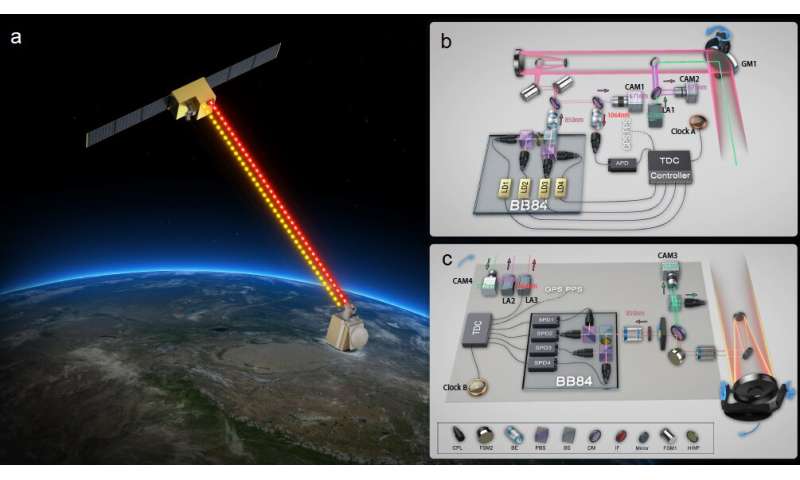A new scheme for satellite-based quantum-secure time transfer
by Ingrid Fadelli
Researchers at the University of Science and Technology of China have recently introduced a new satellite-based quantum-secure time transfer (QSTT) protocol that could enable more secure communications between different satellites or other technology in space. Their protocol, presented in a paper published in Nature Physics, is based on two-way quantum key distribution in free space, a technique to encrypt communications between different devices.
"Our main idea was to realize quantum-secure time transfer in order to resolve the security issues in practical time–frequency transfer," Feihu Xu, one of the researchers who carried out the study, told Phys.org.
Quantum key distribution (QKD) is a technique to achieve secure communication that utilize cryptographic protocols based on the laws of quantum mechanics. Quantum key distribution protocols can generate secret security keys based on quantum physics, enabling more secure data transfer between different devices by spotting attackers who are trying to intercept communications.
In their study, Xu and his colleagues used a similar principle to exploit quantum signals (i.e., single photons) as carriers for what is known as time transfer. Time transfer is essentially the time interval in which data is transferred from one place, or device, to another.
"Thanks to the quantum non-cloning theorem we used, any attempt to intercept the single photon will inevitably disturb the quantum state, which can be checked via post-processing," Xu said. "This allowed us to attain a quantum-secure time transfer scheme."

Xu and his colleagues demonstrated their QSTT protocol by applying it to the Micius quantum satellite. The Micius, named after ancient Chinese philosopher Micius Mozi, is the world's first satellite capable of quantum communications, which was launched into space aboard the Long March-2-D rocket back in August 2016.
"We performed a satellite-to-ground time synchronization using single-photon-level signals and achieved a quantum bit error rate of less than 1%, a time data rate of 9 kHz and a time-transfer precision of 30 ps," Xu explained.
This team of researchers is the first to demonstrate satellite based QSTT using single photons. Remarkably, the time precision achieved by their proposed protocol is comparable to that of T2L2, a state-of-the-art technique to achieve time transfer that was applied on the Jason-2 satellite, which is based on the use of strong classical laser pulses.
The new scheme introduced by Xu and his colleagues could ultimately pave the way toward more secure quantum communications between satellite and a variety of other devices. By demonstrating the feasibility of achieving satellite-based high-precision time transfer with single photons, their work also opens up new interesting possibilities for future research.
"Our work introduces new perspectives for the physics field to exploit quantum technology to attain greater security and higher accuracy for time-frequency transfer, clock synchronization and quantum networks of clocks," Xu said. "We now plan to construct a satellite-based global-scale quantum network to test fundamental physics and to provide practical applications, such as distributing secret keys, synchronizing clocks and so forth."
More information: Hui Dai et al. Towards satellite-based quantum-secure time transfer, Nature Physics (2020). DOI: 10.1038/s41567-020-0892-y
Journal information: Nature Physics
© 2020 Science X Network